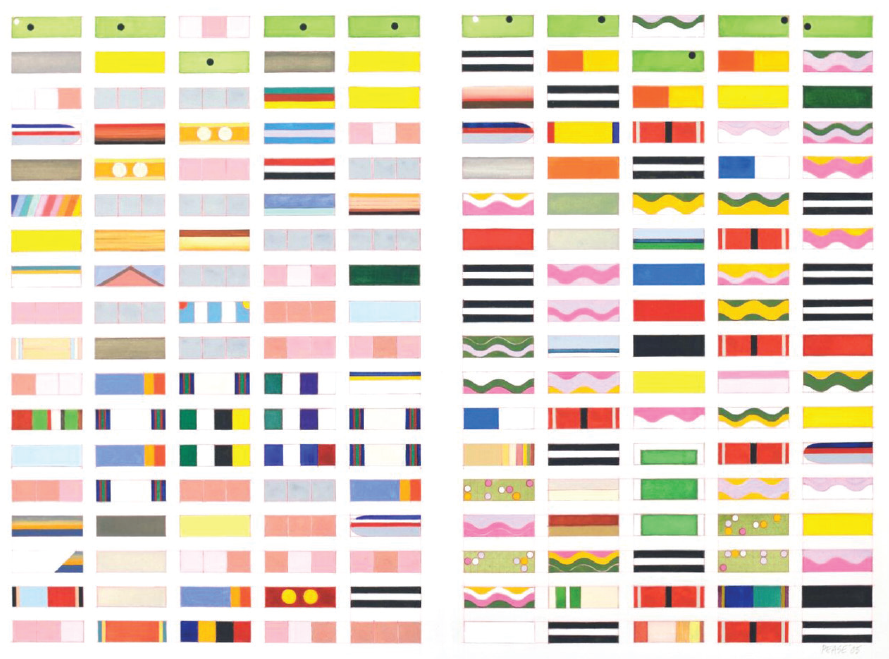
Key Incident, 1994.
One day some years ago, David Pease was swimming off the coast of Tortola when it occurred to him that he’d dropped his hotel room key in the water. This was back in the days when a key was still a key—not a slim plastic card, but an awkward and clunky thing, attached by a brass ring to a slab of heavy plastic. This particular key had gone missing, Pease quickly realized, by becoming dislodged from his own swimsuit pocket, which hardly bears repeating except that a day later—while swimming in the same spot—he found it.
That this became the backstory from which a painting (Key Incident) would later emerge is part of a much bigger story. It’s a story of how logic meets chance, how memory engenders narrative, how observation seeds curiosity, cues language, and sparks form. It is a story of collections and obsessions, of discipline and method, about imagination, investigation, improvisation—and perhaps most of all, about connecting a lifetime of dots.
David Pease makes work that is controlled by accuracy, but thrills to the promises of chance. He is principled, but playful, at once focused and far-ranging in his appeal to the unusual reference.
A checkerboard-branded burger franchise. The title of a song by Fats Waller. An impromptu spray of oyster crackers randomly spotted in a bowl of chowder. In these paintings, there are magical gestures of illusion and deft sleights of hand. There are nods to history, odes to memory, references to moments of delight (meals logged as celebrations of color) and sadness (cemeteries rendered as sober rectangles of white). There are hints of compositional precision and geographic allusion, gestures of wit and grace notes of whimsy. And throughout it all, there is a deep and abiding determination to tell a story.

A Handful of Keys, 2005.
Pease’s stories locate themselves at the nexus of time and space, linking memory to method, form to content. Symbols reflect critical observations—some of them rational and direct, others more cryptic and coded; and the process by which such details reveal themselves becomes its very own kind of journey. The work is architectonic but never didactic: indeed, to pierce the veil separating looking from reading is to enter into a deeper substrate, a narrative complexity that rewards the viewer with added dimension and delight. (The titles of some of Pease’s earlier exhibitions—The Geometry of Memory, for example—hint at the humanity in this work, serving to both frame the narrative and orient the viewer.)

Katrina, 2006.
In an interview in The Paris Review in 1967, the Russian émigré Vladimir Nabokov offered a trenchant observation about his own work. “The pattern of the thing precedes the thing,” Nabokov noted—and indeed, the same might be said about the paintings in this exhibition. In them, David Pease has devised a visual lexicon that frames his own experience: to decode the paintings is to excavate not only meaning but narrative—a schedule, a series of events, the bright purples of a garden (Wild Iris) or the captivating reds in a historic home (Master Lawrie’s Room). There are palettes that echo their physical territory (Great Plains, Western Swing) or their visual vernacular (Land of Lincoln, Painted Houses); and occasionally, there are subtle hints of more mysterious peregrinations (Midnight Gin, 3 Ladies from Antioch, Lock Out). Recurring activities are represented by repeated icons—the black double-stripe of the open road, the silver rounded nose of an Amtrak cab—while more peculiar details are referenced more subtly and are, consequently, a bit trickier to parse. But it is precisely the simultaneous presence of the universal and the unique that gives these paintings their power. Individually and collectively, they are hieroglyphs, at once narrative and abstract, a visual tapestry of one artist’s impeccably rendered tales of the episodic moments that mark our days.
This essay accompanies an exhibition at the Henry Koerner Center for Emeritus Faculty, Yale University 20 September to 21 December 2016.

Great Plains, 2006.
David Pease is an artist, teacher, and former arts administrator who studied at the University of Wisconsin–Madison, earning a B.S. in art (1954), an M.S. (1955), and, following service in the U.S. Army (1955–57), an M.F.A. in 1958. He has taught at Michigan State University (1958–60), the Tyler School of Art, Temple University (1960–83), and Yale School of Art (1983–2000). He served as dean of the art schools at both Tyler (1977–83) and Yale (1983–96) and retired from Yale as Street Professor Emeritus of Painting in 2000. His work has been exhibited in more than 250 exhibitions since 1953 and is represented in the permanent collections of, among others, the Whitney Museum of American Art, Philadelphia Museum of Art, Pennsylvania Academy of the Fine Arts, Yale University Art Gallery, Penn State University, and the RISD Museum. Honors received include a Guggenheim Fellowship (painting), a William A. Clark Award from the Corcoran Gallery of Art, a Lindback Award for Distinguished Teaching, and a Distinguished Alumni Award from the University of Wisconsin. He formerly served on the boards of the Louis Comfort Tiffany Foundation (New York) and the Lyme Academy College of Fine Arts in Old Lyme, Connecticut.
